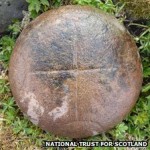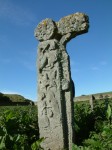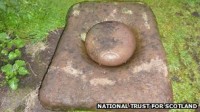 An early Christian bullaun and turn stone have been discovered on the Scottish Inner Hebrides island of Canna. A bullaun is a large rock that has one or more depressions into which stones were turned as part of a folk ritual that started in prehistory and continued well into the Christian era. Bullauns are common in Ireland, but rarer in Scotland, and this is the first Scottish one that has been found complete with its matching top stone.
An early Christian bullaun and turn stone have been discovered on the Scottish Inner Hebrides island of Canna. A bullaun is a large rock that has one or more depressions into which stones were turned as part of a folk ritual that started in prehistory and continued well into the Christian era. Bullauns are common in Ireland, but rarer in Scotland, and this is the first Scottish one that has been found complete with its matching top stone.
 The island was bequeathed to the National Trust for Scotland by Gaelic folklorist John Lorne Campbell in 1981, and the organization maintains it as a conservation area. NTS ranger and Canna native Geraldine MacKinnon found the turn stone first in Canna’s graveyard. The round stone is approximately 10 inches in diameter and engraved with an early Christian cross. The NTS head of archaeology alerted manager Stewart Connor to the find and that it might be linked to a stone with the characteristic bullaun depression next to Canna’s Celtic Cross, an unusually carved stone cross that dates to the 9th or 10th century.
The island was bequeathed to the National Trust for Scotland by Gaelic folklorist John Lorne Campbell in 1981, and the organization maintains it as a conservation area. NTS ranger and Canna native Geraldine MacKinnon found the turn stone first in Canna’s graveyard. The round stone is approximately 10 inches in diameter and engraved with an early Christian cross. The NTS head of archaeology alerted manager Stewart Connor to the find and that it might be linked to a stone with the characteristic bullaun depression next to Canna’s Celtic Cross, an unusually carved stone cross that dates to the 9th or 10th century.
 Too excited to wait until the next morning, Connor went out at 9:00 PM and found that the stone fits perfectly into the depression. Bullaun, despite their pre-Christian heritage, are often found next to early Christian churches, monasteries and artifacts like the Celtic Cross. Canna was owned by the monastery of Iona by 1203, and historians believe it may have belonged to Iona as early as the 7th century.
Too excited to wait until the next morning, Connor went out at 9:00 PM and found that the stone fits perfectly into the depression. Bullaun, despite their pre-Christian heritage, are often found next to early Christian churches, monasteries and artifacts like the Celtic Cross. Canna was owned by the monastery of Iona by 1203, and historians believe it may have belonged to Iona as early as the 7th century.
In Ireland, folklore attached magical significance to bullaun stones, such as the belief that rainwater collected in the stone’s hollow could have healing properties. The St Brigit’s Stone in County Cavan in Ireland was used as a “cursing stone”, and locals would turn the stone while cursing a sworn enemy.
Katherine Forsyth, based at the University of Glasgow and a leading expert in the history and culture of the Celtic-speaking peoples in the first millennium AD, said: “I couldn’t believe my eyes when I saw the first pictures of this beautiful stone. Stones like this are found in Ireland, where they are known as ‘cursing stones’, but this is the first to be discovered in Scotland. […] This exciting find provides important new insight into religious art and practice in early Scotland and demonstrates just how much there is still to be discovered out there.”
There are a number of archaeological remains on the island dating from this period, including a series of highly decorated cross shafts and the hermitage site Sgor Nam Ban-Naomha, or Skerry of the Holy Women, a remote location hidden below steep cliffs which was discovered in 1994.